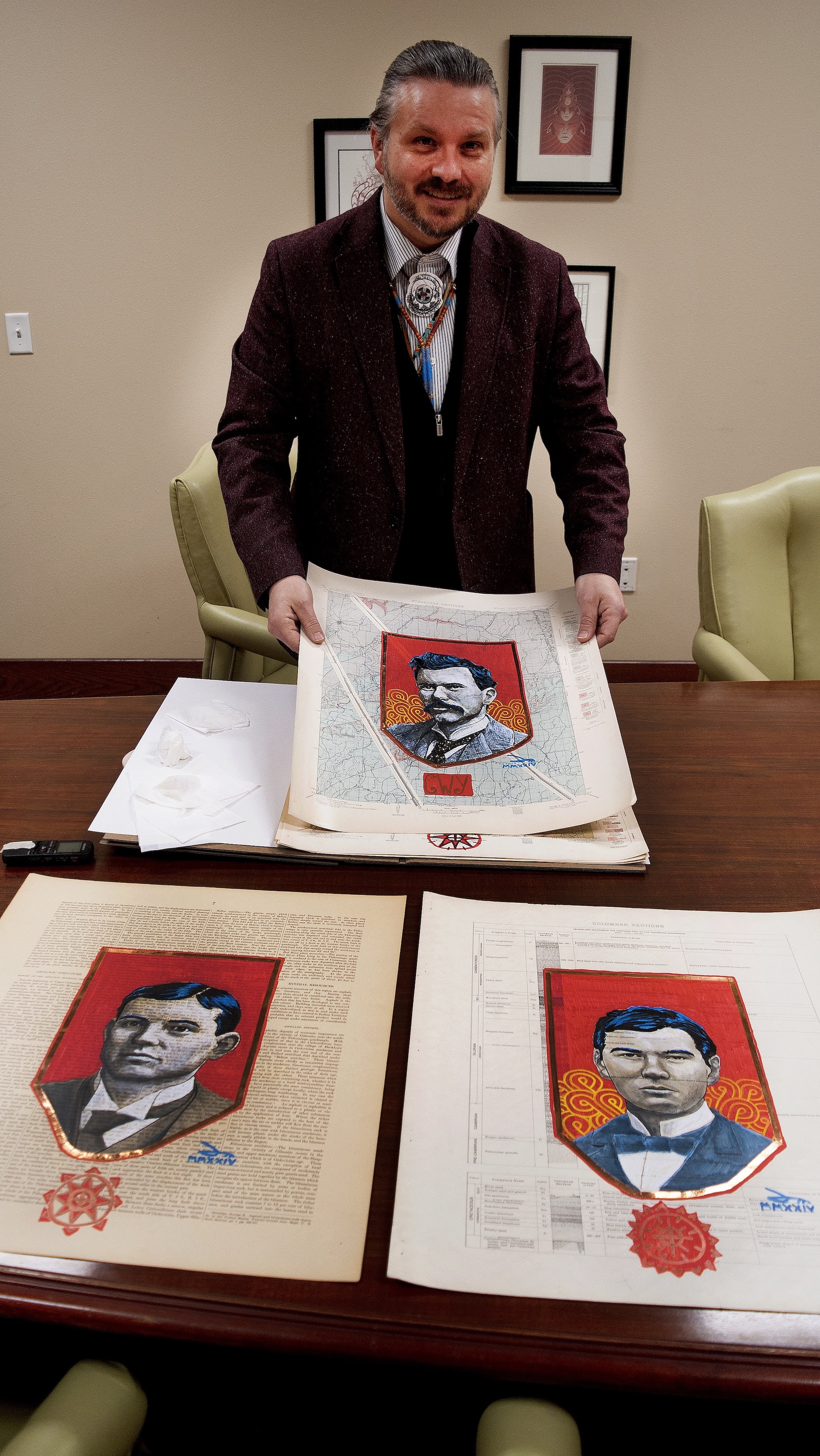
- Details
- By Levi Rickert
NASHVILLE, Tenn. – Vanderbilt University honored artist Dustin Mater with a formal ceremony Nov. 12, officially unveiling 12 portraits of Chickasaw and Cherokee students who attended the highly respected university.
The university commissioned Mater to paint portraits of First American students who fought for admission to Vanderbilt in the late 1880s, won admission and then went on to pursue stellar careers in Indian Territory and later Oklahoma.
Mater, a national and internationally acclaimed artist in several art genres, was on hand at the ceremony to greet attendees and speak about his project, which he finished in February 2024. The Chickasaw artist is also planning to show works at this year’s Hushtola Art Market.
Mater was commissioned by Dan Sharfstein, professor of law and history at Vanderbilt, after a chance encounter in September 2023 at Vanderbilt’s Curb Center, which hosted “Roots of the Cedar Tree” art exhibit in which Mater was involved.
“The more we talked, I remember thinking how cool it was these Native sons were the first nonwhite students admitted to Vanderbilt,” Mater said.
The portraits are painted on Mater’s signature “ledger paper,” artifacts from the late 1800s to 1903 given to him approximately six years ago. The ledger paper used was from a map of Tishomingo, Indian Territory, dated 1898. The other is a map of Tahlequah, Indian Territory, also from 1898, which pays tribute to the First American tribes that each student represents.
“It was an honor to be asked to contribute to this endeavor,” Mater said. “To see First Americans honored for their temerity and fight to gain higher education and serve our people is quite inspiring.”
Another celebrated artist just emerging on the scene is Abby Gaines, a former Chickasaw Princess whose differing art genres have proved popular with art lovers. She also will be showing and competing in Hushtola Art Market after enjoying a successful prize-winning exhibit at the Southeastern Art Show and Market (SEASAM) in October.
Gaines’ “Spam Shakers” won second place in the graphic artists competition at SEASAM. “SEASAM treated me well,” Gaines said. “My piece, ‘Spam Shakers,’ which placed second, sold to a patron on the first day of the show, and I also sold all 25 prints I brought with me of the same piece.” Gaines called the piece “pop art” with a special meaning to First American citizens.
The painting depicts a female Chickasaw stomp dancer using Spam cans as shell shakers. Chickasaw women strap cans onto their legs to keep the rhythm of the stomp dance singer. The shakers are usually made of evaporated milk cans filled with river rocks.
Traditionally, Chickasaw women used shakers made of turtle shells or deer hooves, which can still be enjoyed today but are not used as much as metal cans. In Gaines’ graphic art, it shows a Chickasaw woman keeping the rhythm with cans from Spam attached to her legs.
“Growing up, my family always had Spam in our household, and other family and friends can identify with it too.” Gaines said with a laugh. “It was a lighthearted piece to show our humor and cultural significance all at once.” So popular was the piece, Gaines has ordered additional prints for Hushtola Art Market.
Additionally, other works will be available to purchase. Gaines gave up her Chickasaw Princess crown in September. Calling the end of her reign “bittersweet,” she is now focused on working full time for the Chickasaw Nation and attending East Central University in Ada, Oklahoma, as a studio art major.
Create your own user feedback surveyMore Stories Like This
Zuni Youth Enrichment Project Takes Top Emerging Artist Apprentices to Phoenix for Artistic Exploration and Cultural ImmersionFrom Dishwasher to Award-Winning Chef: Laguna Pueblo's Josh Aragon Serves Up Albuquerque's Best Green Chile Stew
Rob Reiner's Final Work as Producer Appears to Address MMIP Crisis
Vision Maker Media Honors MacDonald Siblings With 2025 Frank Blythe Award
First Tribally Owned Gallery in Tulsa Debuts ‘Mvskokvlke: Road of Strength’
Help us defend tribal sovereignty.
At Native News Online, our mission is rooted in telling the stories that strengthen sovereignty and uplift Indigenous voices — not just at year’s end, but every single day.
Because of your generosity last year, we were able to keep our reporters on the ground in tribal communities, at national gatherings and in the halls of Congress — covering the issues that matter most to Indian Country: sovereignty, culture, education, health and economic opportunity.
That support sustained us through a tough year in 2025. Now, as we look to the year ahead, we need your help right now to ensure warrior journalism remains strong — reporting that defends tribal sovereignty, amplifies Native truth, and holds power accountable.
 The stakes couldn't be higher. Your support keeps Native voices heard, Native stories told and Native sovereignty defended.
The stakes couldn't be higher. Your support keeps Native voices heard, Native stories told and Native sovereignty defended.
Stand with Warrior Journalism today.
Levi Rickert (Potawatomi), Editor & Publisher

